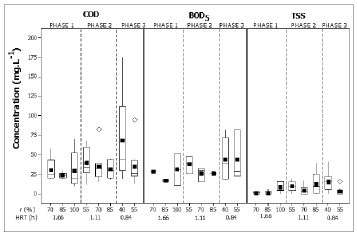Services on Demand
Journal
Article
Indicators
-
 Cited by SciELO
Cited by SciELO -
 Access statistics
Access statistics
Related links
-
 Cited by Google
Cited by Google -
 Similars in
SciELO
Similars in
SciELO -
 Similars in Google
Similars in Google
Share
DYNA
Print version ISSN 0012-7353On-line version ISSN 2346-2183
Dyna rev.fac.nac.minas vol.78 no.168 Medellín Oct./Dec. 2011
PERFORMANCE OF A CONTACT STABILIZATION PROCESS FOR DOMESTIC WASTEWATER TREATMENT OF CALI, COLOMBIA
DESEMPEÃO DEL PROCESO DE ESTABILIZACIÃN POR CONTACTO PARA EL TRATAMIENTO DEL AGUA RESIDUAL DOMÃSTICA DE CALI, COLOMBIA
NANCY VÃSQUEZ SARRIA
Faculty of Engineering, Universidad del Valle, Colombia. navasari1@gmail.com / nancy.vasquez@correounivalle.edu.co
JENNY RODRÃGUEZ VICTORIA
Faculty of Engineering, Universidad del Valle, Colombia. jenny.rodriguez@correounivalle.edu.co
PATRICIA TORRES LOZADA
Faculty of Engineering, Universidad del Valle, Colombia. patricia.torres@correounivalle.edu.co
CARLOS MADERA PARRA
Faculty of Engineering, Universidad del Valle, Colombia. carlos.a.madera@correounivalle.edu.co
Received for review April 14th, 2010; accepted November 4th, 2010; final version November 25th, 2010
ABSTRACT: The contact stabilization process has been applied in full-scale plants which treat domestic wastewater. The main advantage of this process is the short hydraulic retention time (HRT) in the contact reactor (CR), allowing treatment volumes significantly lower than in conventional activated sludge processes. This paper presents an analysis of the influence of the HRT and sludge recycle rate (r), on the performance of a contact stabilization process to remove organic matter and solids from the domestic wastewater of the city of Cali (Colombia). The research was carried out at Cañaveralejo Wastewater Treatment Plant (C-WWTP) facilities. The contact stabilization process was assessed at a pilot-scale unit treating raw wastewater influent to the C-WWTP. The HRT varied between 0.84 to 1.66 h in the contact reactor and 2.56 to 4.65 h in the stabilization reactor (SR). The evaluation of HRT was carried out with different r varying between 40 and 100%.
The operational conditions that allowed for us to obtain the best performance in terms of organic load removal (14.05 kgCOD.d-1), with removal efficiencies of chemical oxygen demand (COD), biological oxygen demand (BOD5), and total suspended solids (TSS) of 86, 87, and 82 %, respectively, were an HRT of 0.84 h in CR, and 4.11 h in SR, with a sludge recycle rate of 40%. In order to guarantee this performance, average values of sludge retention time (SRT) of 6 d; a volumetric organic load (VOL) of 2.13 kgBOD5.(m3.d) -1; a food microorganism relation (F/M) of 0.89 kgBOD5.(kgVSS.d)-1; and a mixed liquor volatile suspended solids (MLVSS) of 1125 mg.L-1 in CR, and 3173 mg.L-1 in SR, must be maintained.
KEYWORDS: Activated sludge, contact stabilization, organic matter removal, secondary wastewater treatment
RESUMEN: El proceso de estabilización de contacto ha sido aplicado en plantas de tratamiento de aguas residuales domésticas a gran escala. La principal ventaja de este proceso está representada en los bajos tiempos de retención hidráulicos (TRH) de operación del reactor de contacto (RC), lo que permite que los volúmenes de tratamiento sean considerablemente más bajos que en los procesos convencionales de lodos activados. Este trabajo presenta un análisis de la influencia del TRH y la tasa de recirculación (r) en el desempeño del proceso de estabilización por contacto para la reducción de materia orgánica y sólidos de las aguas residuales domésticas de Cali. La investigación fue llevada a cabo en las instalaciones de la Planta de tratamiento de aguas residuales de Cañaveralejo (PTAR-C) de Cali. El proceso de estabilización por contacto fue evaluado a escala piloto tratando el agua residual afluente a la PTAR-C. Se estudiaron rangos de TRH entre 0.84 y 1.66 h en RC y entre 2.56 y 4.65 h para el reactor de estabilización (RE). La evaluación del TRH fue realizada con diferentes valores de r Tasas de recirculación de lodos ( r) que variaron entre el 40 y 100 %.
La condición operacional que garantizó el mejor desempeño en términos de carga orgánica eliminada (14.05 kgDQO.d-1) y eficiencias de reducción de DQO, DBO5 y SST (86, 87 y 82 % respectivamente) fue para un TRH de 0.84 h en RC, y 4.11 h en el RE, con una tasa de recirculación del 40%. Adicionalmente, se encontró que para garantizar este desempeño se deben mantener valores promedio de tiempo de retención celular (TRC) de 6 d, Carga orgánica volumétrica (COV) de 2.13 kgDBO5.(m3.d)-1, relación alimento microorganismos (A/M) de 0.89 kgDBO5.(kgSSV.d)-1 y Concentración de Sólidos Suspendidos Volátiles en el Licor Mixto (SSVLM) de 1125 mg.L-1 y 3173 mg.L-1 en RC y RE, respectivamente.
PALABRAS CLAVE: Lodos activados, Estabilización por contacto, reducción de materia orgánica, tratamiento secundario de aguas residuales
1. INTRODUCTION
The activated sludge system is a suspended-growth aerobic process which uses the metabolic reactions of microorganisms to convert biodegradable organic wastewater constituents and certain inorganic fractions into new cell mass and byproducts. This process has been widely applied for the treatment of domestic and industrial wastewater, due to the high efficiency obtained, operational flexibility, and possibility of nutrient removal [1-3].
Contact stabilization, as an activated sludge process modification, comprises two aerated reactors (the contact reactor [CR], and the stabilization reactor [SR]) separated by a sedimentation tank [3-7]. The CR receives the influent flow and the biomass in a starved condition so that soluble material is readily adsorbed and absorbed by the starved biomass.
The mixed liquor leaving the CR is settled and the biomass is concentrated. Then, the biomass is sent to SR, where colloidal material removed from the wastewater in the CR is stabilized. Stabilized biomass is returned to the CR by a biomass recycle flow [8]. Figure 1 shows a schematic representation of the contact stabilization process.
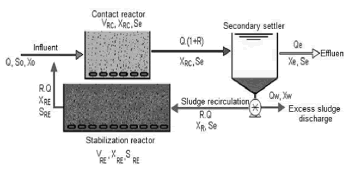
Figure 1. Contact stabilization process
The main design and operating parameters of activated sludge systems include the hydraulic retention time (HRT), the sludge recycle rate (r), the sludge retention time (SRT), mixed liquor volatile suspended solids (MLVSS), the volumetric organic load (VOL), the food microorganism relation (F/M), the sludge settling properties (sludge volumetric index [SVI]), the characteristics of floc, and the concentration of dissolved oxygen (DO) [6, 9, 10].
The HRT is one of the main parameters in the activated sludge system as it is implicitly associated with the organic load applied and the reactor volume. The HRT affects the costs of implementation, operation, and maintenance [11]. For CR, the HRT varies between 0.5 and 1.5 h. For SR, the HRT is determined by the recycle rate (flow recirculation) and can vary between 2 and 6 h [9].
The VOL and F/M represent the organic load applied to the system in terms of the reactor volume and the active biomass, respectively [9, 10]. The F/M can create conditions that favor the predominance of filamentous organisms that affect the settling properties of the sludge, causing brown foam in the aeration tank and deterioration in effluent quality [12, 13].
The SRT, used for the design and operation of the system, is the most important parameter in maintaining the MLVSS concentration, as it influences the evolution of the biochemical transformation processes and is related to the rate of growth of microorganisms, because only the microorganisms capable of breeding in this time can survive and enrich the system [6, 14]. According to Liao et al. [15, 16], Liss et al. [17], and Wilen et al. [18], the SRT can affect the floc structure and the settling properties of the sludge.
The MLVSS represents the amount of biomass in the system. The typical values for activated sludge systems vary between 500 and 5000 mg.L-1 and the recommended concentrations for the contact stabilization process are between 1000 and 3000 mg.L-1 for CR, and between 4000 and 10000 mg.L-1 for SR [6, 9, 19].
The fraction of biomass in CR is called the sludge distribution fraction (a factor), and values recommended are between 0.1 and 0.3 [4, 8]. The SVI indicates the separation efficiency of the biomass of the mixed liquor. According to Withey et al. [20], the settling properties of sludge formed during the activated sludge process are essential for the clarification of the effluent. Jenkins et al. [12] indicated that high values of SVI are associated with sludge bulking and foam problems that affect the effluent quality.
The solids concentration in the secondary settler affect the solids concentration in the recirculation sludge, although if the sludge is concentrated, the recycle rate requirements will be lower in order to guaranteed the MLSSV in the SR, which is also affected by the SRT [6, 9].
The DO concentration is important in the development of processes that occur in the activated sludge systems. The main oxygen requirements are determined by oxidation of organic matter and ammonium through heterotrophic and autotrophic microorganisms respectively [21]. Low levels of DO can affect the sludge settling properties and the metabolic activity of microorganisms, generating an incomplete removal of substrate, which is reflected in the poor effluent quality [22].
Since 1972, studies have been conducted on this process. Between 1975 and 1980 Gujer and Jenkins [5, 7] and Alexander et al. [8] proposed the kinetic models for carbon removal and nitrification, and found that this system can be highly efficient in organic matter removal with efficiencies around 80%. They established that the most relevant operating parameters for this process are the HRT, SRT, r, and ï¡ factor. SarioÄlu et al. [4] applied the contact stabilization process to the domestic wastewater of Istanbul.
The experimental results showed that the treatment efficiency increases when the particulate COD fraction of an influent domestic wastewater increases. Efficiencies observed during the study were around 82%.
Table 1 presents experimental data of WWTP with contact stabilization processes.
Table 1. WWTP with contact stabilization processes
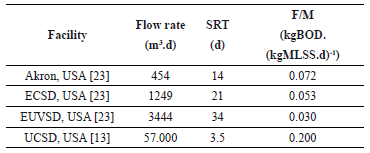
More recently, laboratory-scale biological systems studies were carried out by Universidad del Valle and Water Company of Cali (EMCALI EICE ESP) [24, 25], to treat domestic wastewater from Cali. Four activated sludge processes were evaluated: extended aeration, adsorption/bioxidation (A/B System), conventional, and contact stabilization. The results showed that the application of the activated sludge systems studied is feasible, since COD, BOD5, and TSS removal efficiencies were above 80%. In addition, the contact stabilization process allows the highest organic load removal with the smallest area requirements.
This paper presents an analysis of the influence of the HRT and r in the performance of a contact stabilization process to remove organic matter and solids (COD, BOD5, and TSS, respectively) from the domestic wastewater of Cali.
2. METHODOLOGY
The study was carried out at a pilot-scale wastewater treatment plant in the C-WWTP facilities of Cali.
2.1. Pilot plant
The pilot plant consisted of four sequentially disposed units for preliminary treatment (fine screen and two grit chambers), primary clarification, aeration (for CR and SR), and secondary sedimentation. The wastewater was collected with a submersible pump (Barnes®) located at the entrance of the grit chamber of the C-WWTP. The oxygen was supplied through membrane diffusers and a fine bubble blower system. The recirculation sludge sample was collected by means of a centrifugal pump (Barnes®). Figure 2 shows the pilot plant flowsheet, and Table 2 shows the description of units.
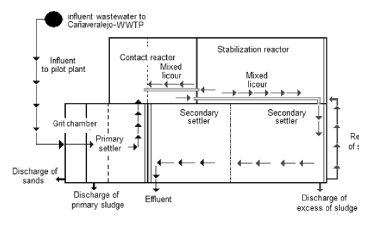
Figure 2. Pilot plant flowsheet
2.2. Wastewater
The pilot plant was fed with the raw wastewater which arrived to the C-WWTP that corresponds to Cali domestic wastewater. Table 3 summarizes the plant wastewater influent and primary effluent average quality parameters.
Table 3. Treatment plant wastewater influent and primary effluent average quality parameters
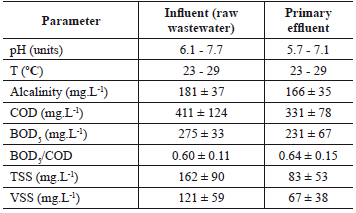
2.3 Operational conditions
The pilot plant was operated for a period of 183 days. The operation was conducted at different HRT and r values. Every HRT variation was called a phase of operation, for a total of three phases. In each phase of operation, r was varied to provide different operational conditions to assess the performance of the system. Table 4 shows the evaluated conditions in each phase.
Table 4. Evaluated conditions in each phase
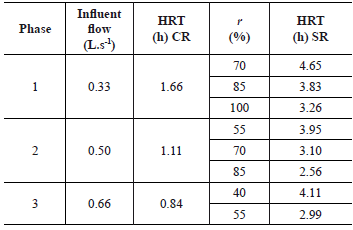
Samples were collected three times a week in the influent and effluent of the system and in the CR, SR, recirculation sludge, and discharge of excess of sludge. The analyzed parameters were: pH, temperature, alkalinity, COD, BOD5, TSS, and VSS. All analytical determinations were according to the Standard Methods for the Examination of Water and Wastewater [26] and the structure of activated sludge floc was observed with optical microscopy, according to Vazollér et al. [27] and Jiménez et al. [28].
For the selection of the operational conditions that showed the best performance in terms of COD removal efficiency, a statistical model for a completely randomized design was used. The tests for the data validation were Bartlet for homogeneity of variances and Kolmogorov-Smirnov for normality. In order to correct non-normality and stabilize subgroup variance, a Box-Cox transformation was used [24, 29].
3. RESULTS AND DISCUSSION
3.1. Analysis of operational conditions
3.1.1. Behavior of operation variables
SRT. Taking into account the results obtained by UNIVALLE-EMCALI [25], the initial value of SRT used in this study was around 10 d. With this condition, the effluent COD concentration was less than 60 mg.L-1; nevertheless, the system showed a high incidence of sludge flotation in the settler, probably caused by the accumulation of the sludge in the secondary settler, whose decomposition processes produced gases that dragged the bottom sludge.
Van Haandel and Marais [1] indicated that for tropical climate conditions, SRT values between 3 and 5 d are enough to ensure the development of predators of bacteria and an effluent with low concentration of organic matter. Considering these aspects, the operation of the system (Phase 2 and 3) was carried out with values of SRT around 6 d. The mean SRT varied between 9 and 12 d, 5 and 8 d, and 5 and 6 d for all three phases, respectively.
The change of SRT to 6 d resulted in a significant reduction of the sludge flotation in the settler unit, without affecting the effluent quality. In all phases the effluent remained with a low COD concentration range (between 20 and 60 mg.L-1), reflecting that the SRT values maintained during the operation of the system allowed for the proper development of biological processes for the removal of organic matter.
Solids in the system. The concentration of solids obtained in the different units showed an effect of increasing r, which was attributed to the increased speed of the settled sludge suction and which generated a less concentrated sludge recirculation. Another variable that could affect the stability of the solids concentration was the secondary settler performance, which did not allow a compaction and distribution of sludge proper, generating accumulation and decomposition of this material in this unit. Figure 3 shows the concentration of solids in the system.
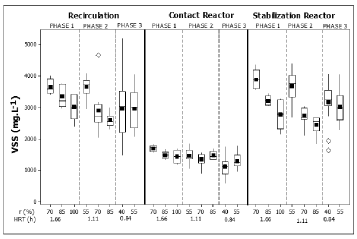
Figure 3. Concentration of solids in the system
An important aspect was that in all operating conditions, the solids concentrations were maintained at values inferior than those typically recommended in the literature, which vary between 1000 and 3000 mg.L-1 for CR, and between 4000 and 10000 mg. L-1 for SR [9]; however, the system performance in terms of removal of COD and TSS showed that the system can be operated with concentrations of VSS around 1500 mg.L-1 for CR, and 3500 mg.L-1 for SR.
In activated sludge systems, the biosorption process, the assimilation of organic matter, and a proper operation of aerated reactors depends on an adequate concentration of biomass in the reactor. This condition is improved in the contact stabilization process; because the sludge is separated into two reactors, where the distribution of the sludge is controlled by factor ï¡.
According to Alexander et al. [8], an a factor value of 0.1 can be sufficient for ensuring the biosorption of organic matter; however, SarioÄlu et al. [4] recommended an optimal value of 0.30. During the three phases, a factor values were between 0.1 and 0.2, which according to the quality of the effluent of the system, were sufficient to ensure good performance.
Organic load. Influent BOD concentration constant values around 231 ± 67 mg.L-1 allowed similar average values of VOL in each phase. Figure 4 presents the behavior of VOL and F/M.
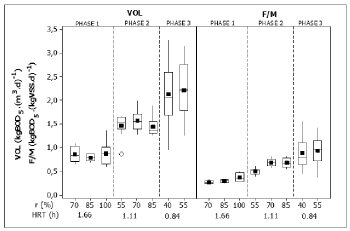
Figure 4. Behavior of the organic load applied
Decreased HRT caused an increase in the VOL and F/M. As a result, values achieved in Phases 2 and 3 exceeded the recommended maximum for this process between 0.2 and 0.6 kgDBO5.(kgSSV.d)-1. Although authors such us Ramalho et al. [30] argue that high values of F/M are related to filamentous organisms, and that this affect the sludge settling properties and quality of the effluent, our results showed that the contact stabilization process can be operated with high VOL without the occurrence of the growth of filamentous microorganisms.
3.1.2. Sludge quality
Figure 5 shows the behavior of SVI. There is a clear trend of the sludge low settling properties (SVI > 100 mL.g-1) associated mainly with the floc structure, which presented a small size, lower floc strength (open structure), and shear sensitivity, due to the low concentration of filaments. The mean floc size varied between 12 to 13 µm for the CR, and 9 to 16 µm for the SR.
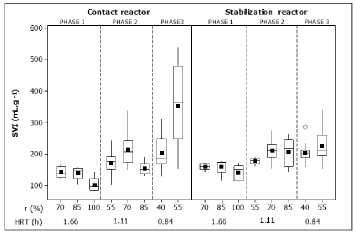
Figure 5. Behavior of sludge volumetric index
According to Li and Ganczarczyk, cited by Wilen et al. [18] this floc size is very small, because typical sizes of flocs usually vary between 20 and 200 µm. Jenkins et al. [12] affirm that the presence of surfactants and toxic substances in wastewater can affect the formation of floc and the bioflocculation process reflected in the predominance of small sizes and dispersed floc.
Another variable that could affect the size of the floc was the turbulence caused by the aeration system. Although DO concentrations were maintained mainly between 1 and 4 mg.L-1 during the three phases, is possible that air bubbles could have caused the breakdown of the floc.
The Phase 3 operation was perturbed by electrical supply interruptions every 3 hours during a week. As a result, the system was operated intermittently, affecting the sludge settling properties, which was reflected in the increase in SVI.
3.2. System performance
3.2.1. Effluent concentration and COD, BOD5, and TSS removal
Figure 6 shows effluent quality. Although in all operational conditions the effluent organic matter and solids concentrations were less than 60 mg.L-1; the overall behavior of effluent quality showed that the average concentration of COD, BOD5, and TSS have been affected by changes in r, and showed a slight increase with decreasing HRT in the CR.
This condition described was related to the discharge of small flocs in the effluent as a result of the decrease in the sludge settling. However, we considered that this impact was not significant since removal efficiencies during all phases, COD, BOD5, and TSS, were above 80% (See Figure 7), indicating a good affinity of the biomass with the influent wastewater. For the range of HRT evaluated, the concentrations obtained from MLVSS in CR and SR were appropriate for ensuring an effluent with low COD concentration.
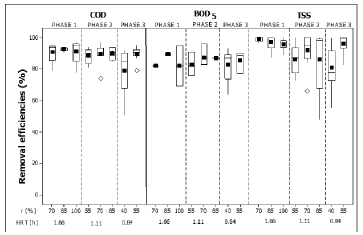
Figure 7. Removal efficiencies of COD, BOD5, and TSS
During the evaluation of Phase 3 with 40% r there was an increase in the average influent COD, BOD5, and TSS concentration. These increases were attributed to disruptions in the aeration system due to electricity supply interruptions in the C-WWTP, which caused instability in the process and reduced COD, BOD5, and TSS removal efficiencies up to values around 50%; although most of the data were between 70 and 90%, with average values of 79, 82, and 81% for COD, BOD5, and TSS, respectively, showing that despite operational drawbacks, the system continued to present good performance in terms of the removal of COD, BOD5, and TSS, and that the system can tolerate some external variations without significantly affecting performance.
3.2.2. Organic load removal
Reduction of the HRT and the increase of VOL and F/M caused an increase in organic load removal (see Figure 8). These conditions can be associated with the fact that increasing organic loads in the system allow for better use of the adsorption capacity of the floc, because there is a greater availability of organic matter for the adsorption processes in the CR.
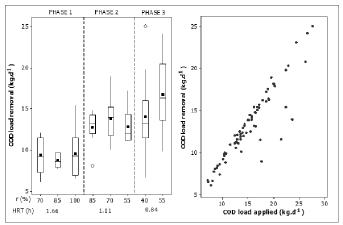
Figure 8. Organic load removal and the relationship between organic load applied and removal
HRT values assessed for Phases 1, 2, and 3, corresponding to 100, 67, and 50 min, respectively (1.66 h, 1.11 h, and 0.84 h) were sufficient to allow for the biosorption and assimilation processes. These results are consistent with studies carried out by Eliosov and Argaman [31] and Guellil et al. [32] who showed that particulate matter is quickly adsorbed by the floc (between 20 and 40 min), although the degradation and absorption is relatively slow.
During the operation of the system with different values of r, HRT in SR varied between 2.56 and 4.65 h, which ensured sludge with a high biosorption capacity reflected in an effluent with low COD, BOD5, and TSS concentration, and a high organic load removal. This aspect indicated that HRT ranges provided in SR with the different sludge recycle rate applied, were sufficient for allowing for the assimilation of organic matter and renewal of the active surface of the floc, since the hydrolysis, degradation, and assimilation of particulate organic material mainly occur in the SR, which completes the assimilation of soluble material that was not assimilated in the CR.
3.2.3. Selection of the optimal operation conditions
Sludge recycle rate. The overall results showed that in the three evaluated phases it is possible to obtain removal efficiencies of COD, BOD5, and TSS above 80%. In order to choose a specific operational condition in the system, the average values of COD load removal were compared using analysis of variance (ANOVA) and orthogonal contrast. Table 5 shows the results obtained from the analysis of COD load removed in each r evaluated.
Table 5. Average values of COD load removal
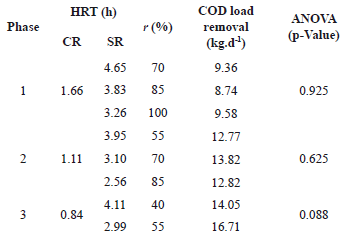
The ANOVA did not show any significant differences between the evaluated r values (p-value > 0.05), indicating that in terms of COD load removal for each phase, it is possible to use any of the r values and obtain similar results for COD load removal. These findings suggest that the variation in the sludge recycle rate do not affect the performance of the system in terms of the COD removal; however these results must be interpreted with caution because the effluent COD and the solids concentration in the system may vary.
For this reason it is important to consider that the sludge recycle rate affects the solids concentration in the SR and the solids are very important for the biosorption processes in the CR [29]; accordingly, the lowest values of r were selected, because for each phase they guaranteed the higher solids concentration in the SR.
Table 6 presents a summary of the best operational condition found for each phase, and average values that must be guaranteed for the main operational variables.
Table 6. Summary of the operational condition found for each phase
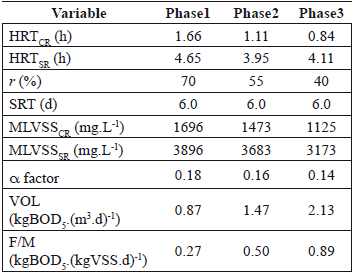
Hydraulic retention time. The overall analysis of system performance showed that decreasing the HRT in CR and increasing the organic load applied to the system improves the biosorption process, due to the increased amount of organic matter per unit volume. Table 7 shows the COD load removed in each phase and the results obtained for ANOVA and comparisons to select the HRT that presents de highest removal of COD load.
Table 7. Statistical analysis for the selection of the phase
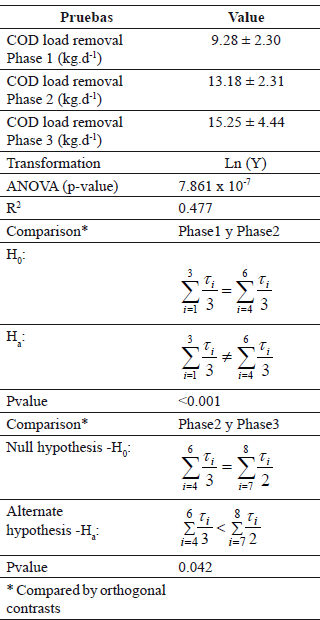
The ANOVA (p-value < 0.05) showed that there was a significant difference in the removal of COD load in the phases; therefore, partial comparisons were made between phases. The level of p-value for the comparison of the COD load removed between phases 1 and 2 was < 0.001 which shows there was a significant difference in Phases 1 and 2, and Phase 2 presented the major COD load removal.
Likewise, the comparison between Phases 2 and 3 (p-value < 0.05) showed that Phase 3 presented the higher COD load removal, and this confirmed the previous analysis in which we mentioned that an increase in VOL applied to the system caused by the reduction of HRT in CR (increased inflow) favored the removal of the COD load, due to better utilization of the biosorption capacity of the floc.
From these results, the evaluated conditions in phase 3 can be recommended as an operational condition for the contact stabilization process in the secondary treatment of Cali domestic wastewater, for a r of 40%. Table 7 summarizes the operational conditions that must be maintained for such performance.
Table 8. Selected operational conditions for the process
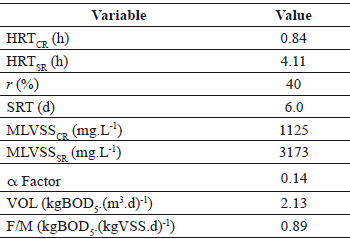
4. CONCLUSION
Organic load removal by contact stabilization process has a potential application for the secondary treatment of the domestic wastewater of Cali.
For the domestic wastewater of Cali, the operational conditions in the contact stabilization process that allowed us to obtain the best performance in terms of removal efficiencies of COD, BOD5, and TSS were an HRT of 0.84 h in CR, and 4.11 h in SR, with an r of 40%. In order to guarantee this performance, average values of SRT of 6 d, VOL of 2.13 kgBOD5.(m3.d)-1, F/M of 0.89 kgBOD5.(kgVSS.d)-1, and an MLVSS of 1125 mg.L-1 in CR, and 3173 mg.L-1 in SR must be maintained
The increase of organic load in the system allows for better use of the biosorption capacity of the floc because there is a greater availability of organic matter for the development of microorganisms in the system.
The hydraulic retention time and the sludge recycle rate have a significant influence on the concentration of VSS in the system, since the increase of the inflow and the sludge recycle rate generate higher suction of sludge, affecting compression, thickening and sludge recirculation concentration, which promotes the recirculation of a diluted sludge and less compacted solids concentration.
5. ACKNOWLEDGMENTS
The authors wish to acknowledge the institutions that supported this work: EMCALI EICE ESP (Water Company of Cali) and Universidad del Valle.
REFERENCES
[1] VAN HAANDEL, A. AND MARAIS, G. O comportamento do sistema de lodo ativado: teoria e aplicações para projetos e operação. Campina Grande, Epgraf, Brasil, 1999. [ Links ]
[2] Gernaey, K. V.; van Loosdrecht, M. C. M.; Henze, M.; Lind, M. and Jørgensen, S. B. Activated sludge wastewater treatment plant modelling and simulation: state of the art. Environmental Modelling & Software, 19(9), 763-783, 2004. [ Links ]
[3] Al-Mutairi, N. Z.; Hamoda, M. F. and Al-Ghusain, I. A. Performance-based characterization of a contact stabilization process for slaughterhouse wastewater. Journal of environmental science and health. Part A - Toxic/Hazardous substances & Environmental engineering, A38(10), 2287-2300, 2003. [ Links ]
[4] SarioÄlu, M.; Orhon, D.; Görgün, E. and Artan, N. Design procedure for carbon removal in contact stabilization activated sludge process. Water Science and Technology, 48(11 - 12), 285 - 292 2003.
[5] Gujer, W. and Jenkins, D. The contact stabilization activated sludge process--oxygen utilization, sludge production and efficiency. Water Research, 9(5-6), 553-560, 1975. [ Links ]
[6] Grady, C. P. L.; Daigger, G. T. and Lim, H. C. Biological wastewater treatment, Marcel Dekker, 2nd. Edition. USA, 1999. [ Links ]
[7] Gujer, W. and Jenkins, D. A nitrification model for the contact stabilization activated sludge process. Water Research, 9(5-6), 561-566, 1975. [ Links ]
[8] Alexander, W. V.; Ekama, G. A. and Marais, G. R. The activated sludge process part 2. Application of the general kinetic model to the contact stabilization process. Water Research, 14(12), 1737-1747, 1980. [ Links ]
[9] Orozco, A. BioingenierÃa de aguas residuales. TeorÃa y diseño. Asociación Colombiana de IngenierÃa-ACODAL, 2005. [ Links ]
[10] von Sperling, M. Lodos ativados. Departamento de engenharia sanitária e ambiental da Universidade Federal de Minas Gerais, Belo Horizonte - Brasil, 1997. [ Links ]
[11] Viero, A. F. and Sant'Anna, G. L. Is hydraulic retention time an essential parameter for MBR performance? Journal of Hazardous Materials, 150(1), 185-186, 2008. [ Links ]
[12] Jenkins, D.; Richard, M. G. and Daigger, G. T. Manual on the causes and control of activated sludge bulking, foaming, and other solids separation problems. Lewis Publishers, Michigan, 2003. [ Links ]
[13] Oerther, D.; De Los Reyes, F.; De Los Reyes, M. and Raskin, L. Quantifying filamentous microorganisms in activated sludge before, during, and after an incident of foaming by oligonucleotide probe hybridizations and antibody staining. Water Research, 35(14), 3325-3336, 2001. [ Links ]
[14] Clara, M.; Kreuzinger, N.; Strenn, B.; Gans, O. and Kroiss, H. The solids retention timeâa suitable design parameter to evaluate the capacity of wastewater treatment plants to remove micropollutants. Water Research, 39(1), 97-106, 2005. [ Links ]
[15] Liao, B. Q.; Allen, D. G.; Droppo, I. G.; Leppard, G. G. and Liss, S. N. Surface properties of sludge and their role in bioflocculation and settleability. Water Research, 35(2), 339-350, 2001. [ Links ]
[16] Liao, B. Q.; Droppo, I. G.; Leppard, G. G. and Liss, S. N. Effect of solids retention time on structure and characteristics of sludge flocs in sequencing batch reactors. Water Research, 40(13), 2583-2591, 2006. [ Links ]
[17] Liss, S.; Liao, B.; Droppo, I.; Allen, D. and Leppard, G. Effect of solids retention time on floc structure. Water Science & Technology, 46(1), 431-438, 2002. [ Links ]
[18] Wilén, B. M.; Jin, B. and Lant, P. Impacts of structural characteristics on activated sludge floc stability. Water Research, 37(15), 3632-3645, 2003. [ Links ]
[19] Metcalf and Eddy. Wastewater engineering: treatment and reuse. Metcalf & Eddy. Inc.-McGraw-Hill, New York, 2003. [ Links ]
[20] Withey, S.; Cartmell, E.; Avery, L. M. and Stephenson, T. Bacteriophages - potential for application in wastewater treatment processes. Science of the Total Environment, 339(1-3), 1-18, 2005. [ Links ]
[21] Rosso, D. and Stenstrom, M. Comparative economic analysis of the impacts of mean cell retention time and denitrification on aeration systems. Water Research, 39(16), 3773-3780, 2005. [ Links ]
[22] Madeiros, U.; Cavalcanti, P. and van Haandel, A. Influência da concentração de oxigênio dissolvido sobre o desempenho de sistemas de lodo ativado. Brasil, 2005. [ Links ]
[23] Schultz, J. R.; Hegg, B. A. and Rakness, K. L. Realistic sludge production for activated sludge plants without primary clarifiers. Journal Water Pollution Control Federation, 54(10), 1355-1360, 1982. [ Links ]
[24] UNIVALLE-EMCALI. Estudio de evaluación para el tratamiento del efluente de la PTAR Cañaveralejo a través de dos opciones secundarias convencionales. Informe final Fase II. . Universidad del Valle; EMCALI EICE ESP, Santiago de Cali, Colombia, 2007. [ Links ]
[25] UNIVALLE-EMCALI. Estudio de evaluación para el tratamiento del efluente de la PTAR Cañaveralejo a través de dos opciones secundarias convencionales. Informe final Fase I. Universidad del Valle; EMCALI EICE ESP, Santiago de Cali, Colombia, 2006. [ Links ]
[26] American Public Health Association, American Water Works Association, and Water Environment Federation. Standard methods for the examination of water and wastewater. Washington DC, USA., 2005. [ Links ]
[27] Vzazollér, R.; GarcÃa, M.; Garcia, A. and Conciçao, J. Microbiologia de lodos ativados. CETESB, Sao Paulo, Brasil, 1989. [ Links ]
[28] Jiménez, C.; Fernández, N.; de la Horra, J.; RodrÃguez, E.; Isac, L.; Salas, D. and Gómez, E. Sistema rápido de estimación de los rendimientos de depuración de una EDAR en función de las caracterÃsticas macroscópicas del fango activado. TecnologÃa del Agua, Año 21(216), 40-44, 2001. [ Links ]
[29] Vásquez, S. N. Evaluación a escala piloto del sistema de lodos activados en las modalidades de estabilización por contacto y convencional como alternativa de tratamiento secundario para el agua residual doméstica de la ciudad de Cali. [M.Eng. Thesis]. Santiago de Cali, Colombia: Universidad del Valle, 2009. [ Links ]
[30] Ramalho, R. S.; Beltran, D. J. and de Lora, F. Tratamiento de Aguas residuales. Reverté, 2da. Edición, Barcelona, 1991. [ Links ]
[31] Eliosov, B. and Argaman, Y. Hydrolysis of particulate organics in activated sludge systems. Water Research, 29(1), 155-163, 1995. [ Links ]
[32] Guellil, A.; Thomas, F.; Block, J. C.; Bersillon, J. L. and Ginestet, P. Transfer of organic matter between wastewater and activated sludge flocs. Water Research, 35(1), 143-150, 2001. [ Links ]














